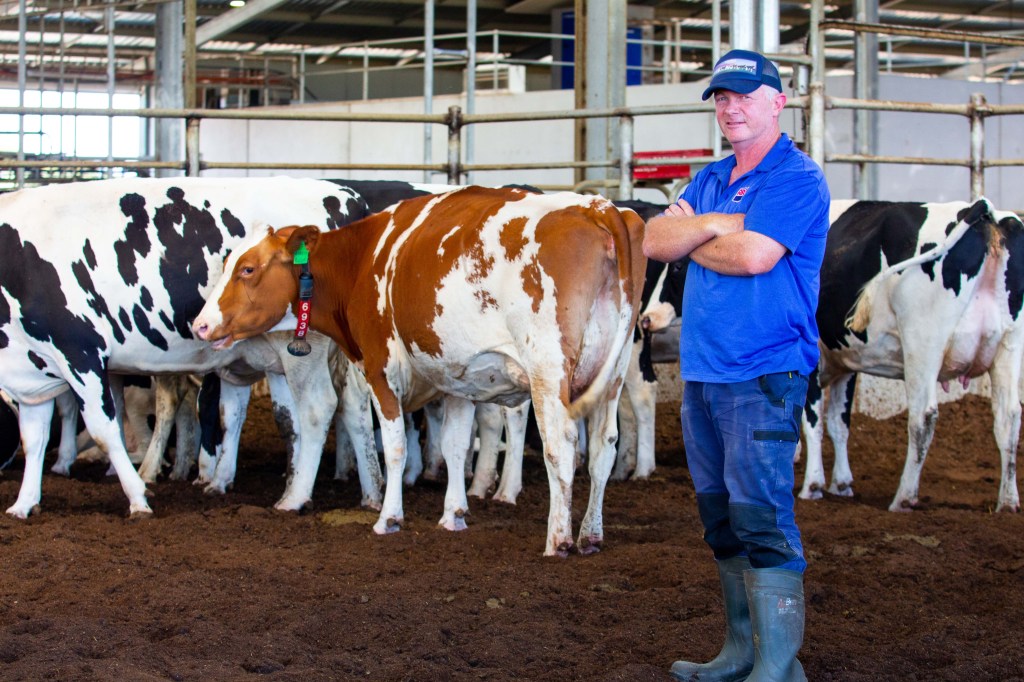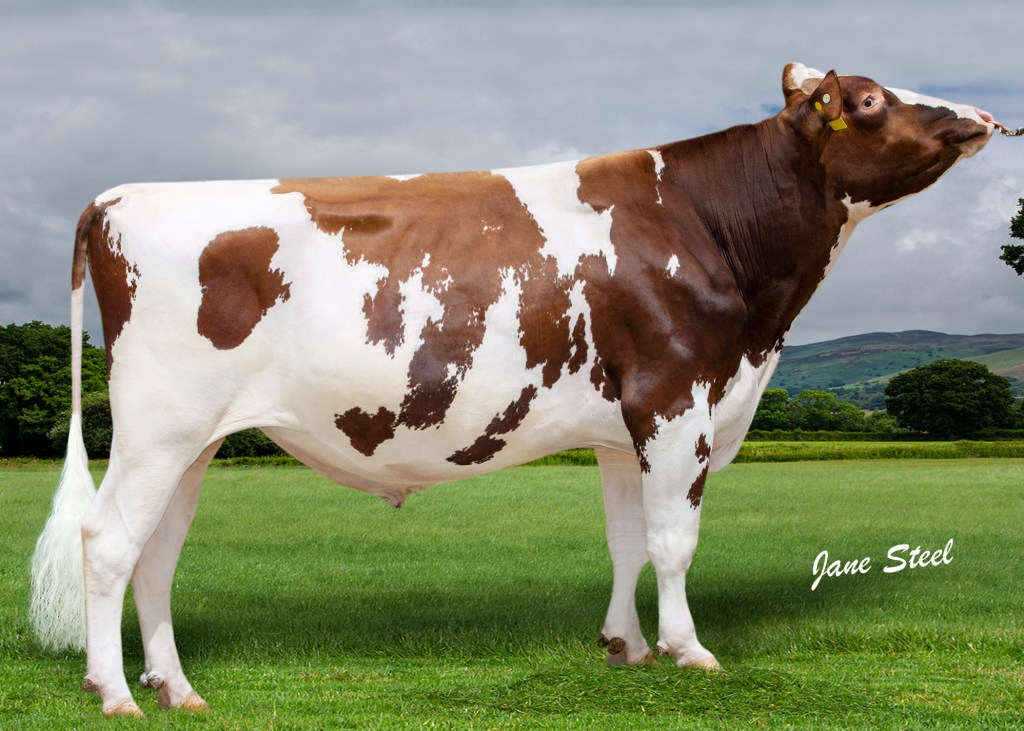All-rounder RUBELS RED pays his way in Northern Victoria
Milking their cows using robotics, the Dee family are now stricter with their breeding criteria than ever before. And that’s saying a lot for the family behind the two-time Master Breeder herd from Northern Victoria.
Adam, Colin, Mark, their father Adrian, and Mark’s wife Mandy love nothing more than examining the cow families, and proofs of global Holsteins. Their Clydevale herd is testament to this dedication. But now milking 500 cows year-round under a barn, their technology requires specific cows. “There is a bit of a limit in what we can use with robots,” Adam said. “Any bulls that throw close rear teats or short teats, they are hard to milk with robots. This limits the pool, especially in Reds, because a lot of Reds have short teats.”
Add to this their requirement for positive milk and Daughter Pregnancy Rate bulls, finding a Red Holstein to fit their system hasn’t been simple.
Enter Hoogerhorst DG OH RUBELS RED. “He’s a good allrounder,” Adam said. “They are good cows to work with, they have good temperaments, are aggressive feeders, get back in calf and are milking well.”
RUBELS RED made history in the recent Australian Breeding Values (ABV) release as the highest Type proven Holstein. Ranked at number 17 on the ABV Holstein proven list, he’s also the most successful Red Holstein.
Clydevale Holsteins has nine RUBELS RED daughters, five are in the milking herd – one just finished its first lactation – two are on the point-of-calving and one is at joining age. An outcross sire, the Dees used RUBELS RED across Red Holsteins and red-factor Black and White Holsteins.
His heifers are not only paying their way in the vat, but they are also “milking themselves” – a valuable characteristic for robotic dairy farmers. “It’s a big time saver, if they all milked themselves we’d save a lot of time,” Adam said. “That’s because we always have to collect some (for milking) in the morning and at night, we don’t want to leave it to chance. The RUBELS, we never have to collect them, when we release the robot, after milking the collected cows, the RUBELS are standing there, ready to be milked, and a little annoyed they had to wait.”
It’s this assertiveness at the robot and feed face that ensures RUBELS REDs are low maintenance cows. Clydevale Rubels Bambino has a PI of 113 and at 292 days in milk was still producing 26.5 litres a day with 4.3 per cent butterfat and 3.6 per cent protein. She milked herself more than three times a day on average throughout her first lactation. Clydevale Rubels Rosa is on track to produce 9500 litres in her first location, with 4885 litres under her belt at 158 days in-milk. A PI of 105 and 4.2 per cent fat and 3.9 per cent protein – her average production across her lactation has been 31litres/day. Both these heifers were also pregnant from their first joining of conventional semen, calving in at 24 months-of-age.
Adam also scored the RUBELS RED heifers well for their likeability, temperament, and milking speed, with the robots confirming they were all above average when it came to milking speed. Sexed RUBELS RED was also used recently to breed their black and white Colt45 daughter of the North American World Dairy Expo Champion Red Cow Blondin Destry Sally. “It was the last sexed RUBELS RED we had in the tank,” Adam said. “We thought ‘let’s try and get a heifer out of her’.”
The Clydevale herd includes less than 100 Red Holsteins out of a total 1200 females. A move into Red and White Holsteins was inspired by the increase in marketability of these animals and the launch of an annual specialist Red and White Holstein competition at Bendigo. “The Victorian Winter Fair, it’s the first to have a standalone Red show – the only in the country,” Adam said. “If we haven’t got Reds, it is part of the show we can’t participate in.”
The Dee family use a lot of sires, joining all the time, they “hand mate” every cow to correct faults. Type is a huge consideration for breeding as they believe breeding conformation correctly is the key to good cows that milk well and last a long time. Their initial interest in RUBELS RED was underpinned by his outcross pedigree, but his “all round” proof cemented his place in the herd. “There are no major holes (in his proof) you have to worry about, he is a pretty easy bull to use,” Adam said.

Red Holstein ticks production goals in Western Victoria
Paul Finlayson breeds for production and type – in that order. And it’s because of this philosophy that he “didn’t like” a lot of the Red Holsteins on the market. Until recently. “A lot of Reds have had a lot of type and no production,” he said. “But RUBELS RED, his genomics showed he was high for production and type, the idea of a Red bull with production got me.”
Now, Paul and wife Karen milk two Hoogerhorst DH OG RUBELS RED progeny and have another two to come in this year plus a yearling. They also have plans to use him again within their stud Fire Lake Holsteins – but this time as a proven sire.
One of the RUBELS RED heifers produced 8000 litres in her first lactation, just shy of the entire 80-cow herd annual average of 9200 litres. Her diet included pasture, hay and 1.5 tonnes of grain in the bail. But it was the weather conditions – an extended cold and wet winter and spring – that made this lactation one to admire. “Any cattle that milked well this year are good cattle because of the season, the way it was,” ABS Western Victoria Key Account Manager Rex Barry said. “That winter, it went so long.”
This RUBELS RED was Paul and Karen’s second highest production heifer in the past year.
She was also classified 84. The other RUBELS RED came in at 83. They also had exceptional cell counts, contributing to the Finlaysons’ award-winning annual bulk milk cell count average of 40,000 cells/ml. This wasn’t surprising, for Rex. RUBELS RED has a cell count of 174 with a reliability of 82 per cent. He said it’s these figures, his production and well-rounded proof that’s made RUBELS RED popular with commercial farmers. “Reds, when they came out, they were just show cattle,” Rex said. “Now, they don’t just fit into a commercial herd, they do really well.”

